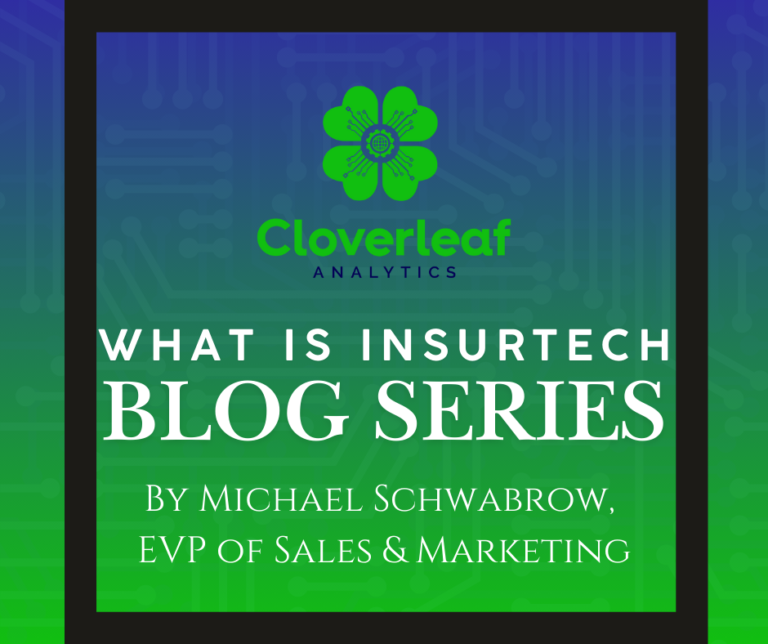What’s the Best AI for My Insurance Business? Short Guide to Help You Decide.

By Michael Schwabrow, EVP of Sales & Marketing, Cloverleaf Analytics

After spending quality time with insurance leaders at the AAIS Main Event in Clearwater, Florida, one question came up repeatedly: “Which type of AI is the best fit for my insurance business?”
It’s a timely and important question—one that insurers can’t afford to put off much longer.
AI has moved beyond buzzword status (like the cloud once was) and is now delivering tangible benefits for P&C insurers of all sizes. However, figuring out what type of AI to invest in (and where to start) is no small feat.
Let’s demystify the options by walking through the key AI categories, starting from the moment a potential policyholder lands on your website.
- Customer-Facing AI: Smart Always-On Service
AI chatbots and virtual assistants are becoming an integral part of insurer operations. However, they’re not just for big insurance carriers with massive budgets. Even small agencies are deploying chatbots to answer routine questions, triage inquiries, and free up agents for more complex work.
This feature isn’t just nice-to-have anymore. A 2024 survey found that 83% of insurance customers are satisfied with their chatbot experiences, and the global insurance chatbot market is expected to reach $4.5 billion by 2032, displaying rapid growth at a CAGR of 25.6% from 2023 to 2032.
Expect this to go even further with generative AI. At Allstate, for example, AI now drafts around 50,000 customer-facing emails a day, reviewed by adjusters before sending. It saves time and helps ensure clear, consistent communication.
- Underwriting & Risk Assessment: Smarter Pricing, Less Guesswork
This is an area where AI shines for insurers looking to refine their risk models and price more competitively. AI-powered underwriting can reduce human error, speed up quote delivery, and boost accuracy.
Insurers like Lemonade are issuing renters’ policies in 90 seconds using AI. Aviva, after embedding AI across its claims and risk processes, reduced customer complaints by 65% and improved its Net Promoter Score by more than 7X.
AI also enables deeper use of unified insurance data. Machine learning models can analyze third-party data, behavioral analytics, and even IoT inputs (like Hippo’s leak sensors) to underwrite policies more proactively and avoid losses before they happen.
- Claims AI: Fast, Fair, and Frictionless
Claims are where AI has perhaps the most significant impact. P&C carriers using computer vision and NLP tools are settling simple claims in minutes—sometimes seconds.
For example, CCC Intelligent Solutions reports that over 300 auto insurers now use its AI to analyze vehicle damage photos, generating estimates quickly and helping policyholders move on faster.
Beyond speed, AI can boost fraud detection and prevention. Advanced models can catch unusual patterns that may go unnoticed in manual reviews, which is critical when U.S. consumers are impacted by hundreds of billions of dollars annually according to the Coalition Against Insurance Fraud.
- Predictive Insights & Business Intelligence: Seeing What’s Next
AI isn’t just about automation. It’s also about foresight.
From policyholders likely to switch carriers to flagging which insurance claims might escalate to litigation, AI helps insurers act sooner and smarter. Predictive models can improve retention, spot fraud trends, sharpen pricing strategies, and reduce loss ratios.
AI can augment your ability to see what is coming across several key risk factors to protect the insurer and the insured from risk.
So, What’s the Right AI for Your Insurance?
Insurers that are deploying AI tools are starting to see tangible benefits. A 2025 survey by Roots found that nearly 90% of insurance executives identify AI as a top strategic initiative, with 82% integrating it into their corporate strategies to enhance financial and operational performance. However, only 20% have AI solutions actively running in production, highlighting a significant gap between strategic thought and practical implementation.
So, if your insurance business is a little behind in adopting AI, here are some tips to get started.
First, ensure your business and technical leadership teams are aligned on your organization’s priorities, and the key intangibles that you need to achieve your annual goals.
Then, use a simple Q&A like the one I created below to help align your team and clarify priorities.
– Want to reduce support volume and improve service consistency? Start with a chatbot.
– Need to improve pricing accuracy or underwriting speed? Risk modeling AI may be your best bet.
– Looking to lower claim cycle times or combat fraud? Look to claims automation and fraud detection tools.
As I’ve mentioned before, for AI to be meaningful, insurers must get their insurance data in order first. This is an area Cloverleaf has excelled at partnering with insurers on for a decade.
Whatever your focus, AI is no longer a moonshot. It’s a practical path to operational efficiency, improved customer experience, and growth.
Start small. Choose a use case. Then build from there.
Because the real question isn’t just “Which type of AI is best?”—it’s “Which part of your business is ready for AI now?”
Check out our Platform section for more details on our services.
